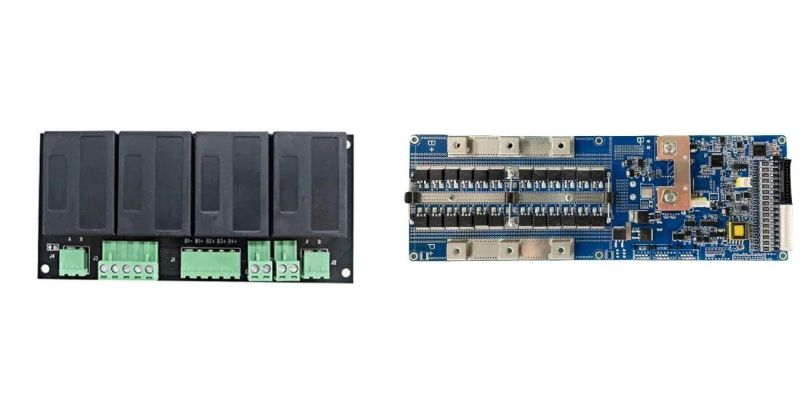
Lithium batteries play a vital role in modern electric vehicles (EVs), energy storage systems (ESS), and portable devices. To ensure the safety, efficiency, and longevity of lithium battery systems, the Lithium Battery Protection Board (PCB) and the Battery Management System (BMS) are indispensable core components. This article provides an in-depth analysis of their functional differences, working mechanisms, and the development trends of the global BMS market.
The primary role of the Lithium Battery Protection Board (PCB) is to provide fundamental charge/discharge safety protection for battery packs. Its core functions include:
Overcharge Protection: Prevents battery voltage from exceeding the safety threshold.
Over-discharge Protection: Avoids damage caused by excessively low battery voltage.
Overcurrent and Short Circuit Protection: Prevents large instantaneous currents from flowing through the battery, which could cause burnout.
Overtemperature Protection: Monitors temperature changes and cuts off the circuit promptly.
Voltage Balancing Function: Maintains voltage consistency among multiple cells, enhancing overall cycle life.
Balancing Protection Mechanisms Explained:
Passive Balancing (Dissipative):
Uses resistors to dissipate energy, discharging higher-voltage cells until they match others.
Balancing During Charging: Activated during the charging process to reduce cell differences.
Fixed Voltage Point Balancing: Begins balancing at a preset voltage, typically near the end of charging.
Static Automatic Balancing: Automatically balances whenever voltage differences exist, even when the battery is neither charging nor discharging.
Active Balancing (Energy Transfer):
Transfers charge from higher-capacity cells to lower-capacity cells, representing a more efficient mechanism.
Continuous Capacity Balancing: Monitors and balances continuously throughout operation, suitable for large-scale battery packs.
Fixed Capacity Point Balancing: Activates balancing at a specific State of Charge (SOC).
The Battery Management System (BMS) acts as the "brain" of modern power battery systems. It not only provides basic protection functions but also integrates capabilities for battery monitoring, communication, and intelligent control.
Core Functional Components:
Real-time monitoring of voltage, current, and temperature.
State of Charge (SOC) estimation.
State of Health (SOH) and Remaining Useful Life (RUL) assessment.
Energy prediction and charge/discharge control strategies.
Integration of communication protocols (e.g., CAN, RS485) for interaction with vehicle/energy systems.
Fault diagnosis and alarm mechanisms.
Safety Mechanisms and Intelligent Control:
The BMS ensures battery safety during normal operation and can immediately cut off power in emergencies (e.g., collision, thermal runaway) to prevent accidents from escalating. Furthermore, the BMS performs state analysis on individual cells, executes active balancing control, delays cell degradation, and enhances overall pack efficiency.
Item | Lithium Battery Protection Board (PCB) | Battery Management System (BMS) |
Core Role | Basic Protection, Balancing | Intelligent Monitoring, Comprehensive Management |
Composition | ICs, Resistors, Capacitors, MOSFETs | MCU, Sensors, Communication Modules |
Programmable? | No | Yes |
Application Area | Consumer Electronics, Portable Devices, Simple Power Packs | Electric Vehicles, Energy Storage Systems, Large Power Batteries |
Cost | Low | High |
Scalability | Poor | Excellent |
Market Drivers:
Surging sales of New Energy Vehicles (BEV/HEV/PHEV) driving BMS demand.
Government subsidies and policy support (e.g., EU Green Deal, China's "Dual Carbon" goals).
Increasing user focus on battery life and safety, boosting demand for advanced BMS.
Key Technology Trends:
Rapid development of AI algorithms for predicting SOH and RUL.
Gradual commercialization of Wireless BMS (wBMS) and modular architectures.
Functional Safety (ISO 26262) and Cybersecurity (ISO 21434) standards becoming industry requirements.
Market Challenges:
Complex system design requiring highly customized BMS for different vehicle models.
Lagging charging infrastructure limiting the full potential of BMS intelligent control capabilities.
By Vehicle Type:
Passenger Vehicles: Widest application, mature technology, expected to maintain market dominance.
Commercial Vehicles: Higher demands on BMS reliability and energy prediction capabilities.
By Powertrain Type:
BEVs: Rely on high-energy-density lithium batteries, requiring high-precision SOC management.
PHEVs/HEVs: Place greater emphasis on thermal management and protection logic during frequent operational mode switching.
By Region:
North America & Europe: High technical standards, strong focus on functional safety, high BMS penetration.
China & India: Leading global growth rate in NEVs, significant policy benefits.
Middle East & Latin America: Early adoption phase, high growth potential, still requiring policy and infrastructure support.
Edge AI Integration: Optimizing energy allocation and state assessment through real-time algorithms.
Software-Defined Battery (SDB): Enhancing system flexibility via Over-the-Air (OTA) remote updates.
Co-design with Thermal Management & Charging Systems: Improving overall pack performance.
Amidst the global wave of new energy adoption, the differences between the Lithium Battery Protection Board and the BMS extend beyond functional depth and application scope; they represent a crucial link in the future intelligent evolution of power systems. We believe that those who achieve highly intelligent, safe, controllable, and integrated battery management systems will hold the core key to the future of new energy.
Next:None
Previous:REPT BATTERO Energy Storage Products Set New Benchmark in Safety with Large-Scale Fire Test Success